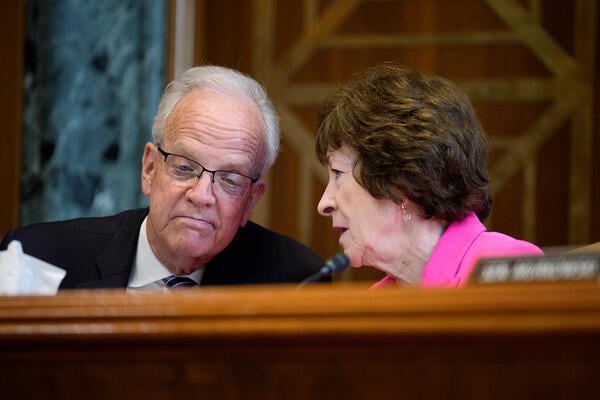
Senate Rejects Trump’s Cuts to NSF, Other Science Agencies
Sen. Jerry Moran, Republican of Kansas, proposed sending $9 billion to the National Science Foundation.
Andrew Harnik/Getty Images
Signs that Congress intends to push back on the Trump administration’s wholesale slashing of federal budgets emerged during a Senate meeting Thursday that kicked off the annual appropriations process.
Since January, the Trump administration has sought to significantly downsize the federal government via mass layoffs and spending cuts. Additionally, the administration has canceled grants and withheld funding despite laws that require agencies to spend money as directed by Congress.
However, on Thursday a subcommittee that oversees the budgets for the Justice and Commerce Departments as well as related science agencies proposed only a small cut to the National Science Foundation budget next fiscal year—a far cry from the $5 billion reduction that President Donald Trump wants to see.
Instead, NSF will get just over $9 billion, a $16 million cut, said Sen. Jerry Moran, the Kansas Republican who chairs the subcommittee. The bill also sends about $10 million more to the National Weather Service and boosts funding for National Aeronautics and Space Administration.
Although the science funding received bipartisan support, a fight over funding for the new Federal Bureau of Investigations headquarters could tank the legislation. Sen. Chris Van Hollen, a Maryland Democrat and vice chair of the subcommittee, objected to the Trump administration’s decision to move the headquarters to another building in Washington, D.C., rather than moving forward with a plan approved during the Biden administration to build a facility in Maryland. (Congress previously appropriated money for a new headquarters and set the criteria for the site selection.)
After the Senate appropriations committee approved an amendment on Thursday from Van Hollen related to the headquarters, some Republicans on the committee changed their vote on the legislation and the panel recessed instead of making a final decision on whether to advance it.
“I think it’s sad that one issue is sinking a bill that was bipartisan,” said Sen. Susan Collins, a Maine Republican and chair of the full appropriations committee.
Still, Van Hollen said earlier in the meeting that there was “a lot of good news” in the legislation.
“We were able to make smart and targeted investments to help keep our community safe, keep our country safe, to advance U.S. leadership in science and innovation and to support growth and prosperity of the American economy. We were able to protect agencies and programs like NASA science and STEM, [the National Oceanic and Atmospheric Administration and] NSF.”
Higher education groups and research advocacy organizations had warned that slashing NSF’s budget by more than half would be catastrophic and set U.S. research back by decades. The Trump administration sought to end funding for STEM training and NSF’s education programs and significantly reduce the money available for scholarships and postdoctoral fellowships.
The committee didn’t release any other information about the budget bill such as the text or a summary, so it’s not clear what the line-item budget for NSF looks like. The available details come from what lawmakers said at Thursday’s meeting.
Van Hollen and Moran said that NASA would get about $24.5 billion to boost space exploration, whereas the administration has requested $18.8 billion.
The additional $10 million for the National Weather Service would go toward restaffing an agency that’s lost about 17 percent of its head count—or 600 employees—due to buyouts and layoffs. NWS’s parent agency, NOAA, lost about 11 percent of its staff. The Trump administration requested about $91 million more for NWS and to cut NOAA’s budget by about $1.8 billion.
After the government imposed significant reductions in force across federal agencies, lawmakers wrangled over details in the proposal that ensure NWS has enough personnel to continue functioning. The bill requires the agency to be fully staffed, but it doesn’t specify what that means aside from requiring the agency have enough employees to fulfill its statutorily required mission. Sen. Brian Schatz, a Democrat from Hawaii, didn’t think that language was strong enough to protect NWS and wanted to set the minimum staffing levels at the number of employees as of Sept. 30, 2024.
“My judgment and the judgment of a lot of people who work at the National Weather Service is that ‘to fulfill the statutory mandate’ gives a fair amount of room to assert that the current staffing levels and the current layoff process fulfills the statutory mandate,” he said. “It’s clear to me that this administration has already made the judgment that the National Weather Service has too many human beings.”
Moran said he and Schatz shared the “same desire,” but he didn’t want to specify a number. Other Republicans pointed out that NWS staff has fluctuated over the years. In fiscal year 2024, the agency had about 4,300 full-time employees, according to budget documents. Republicans voted down Schatz’s amendment.
Moran noted earlier in the meeting that the language in the budget bill should protect NWS employees from furloughs or future reductions in force and end a hiring freeze.
“This bill protects key science missions that are fundamental to furthering our understanding of the Earth and better stewards of our natural resources, and supports critical programs, not only to drive discovery, but to safeguard the Earth from natural disasters,” Moran said.
Congress has until Sept. 30 to pass the 12 appropriations bills that make up the federal budget or else the government could shut down. Democrats and some Republicans also want to use this process to reassert Congress’s authority in spending decisions.
“The challenges we face and the threats to this very process are greater than ever before with the president and administration intent on ignoring the laws that we write and seizing more power for themselves,” said Sen. Patty Murray, a Democrat from Washington and vice chair of the appropriations committee.
“But at the end of the day, I do believe these bills are all a good compromise starting point, delivering critical resources to continue key programs and make targeted new investments—rejecting some of the truly harmful proposed cuts by the president and steering clear of the extreme partisan policies he’s requested.”
Source link



